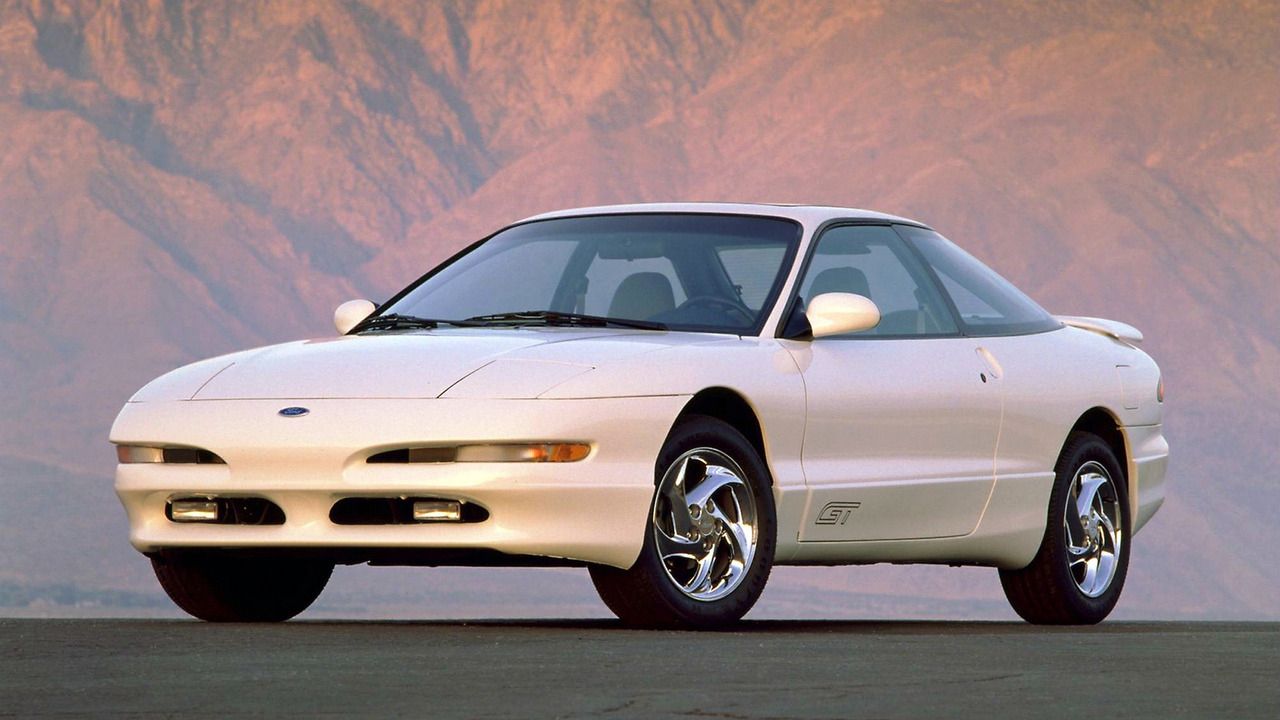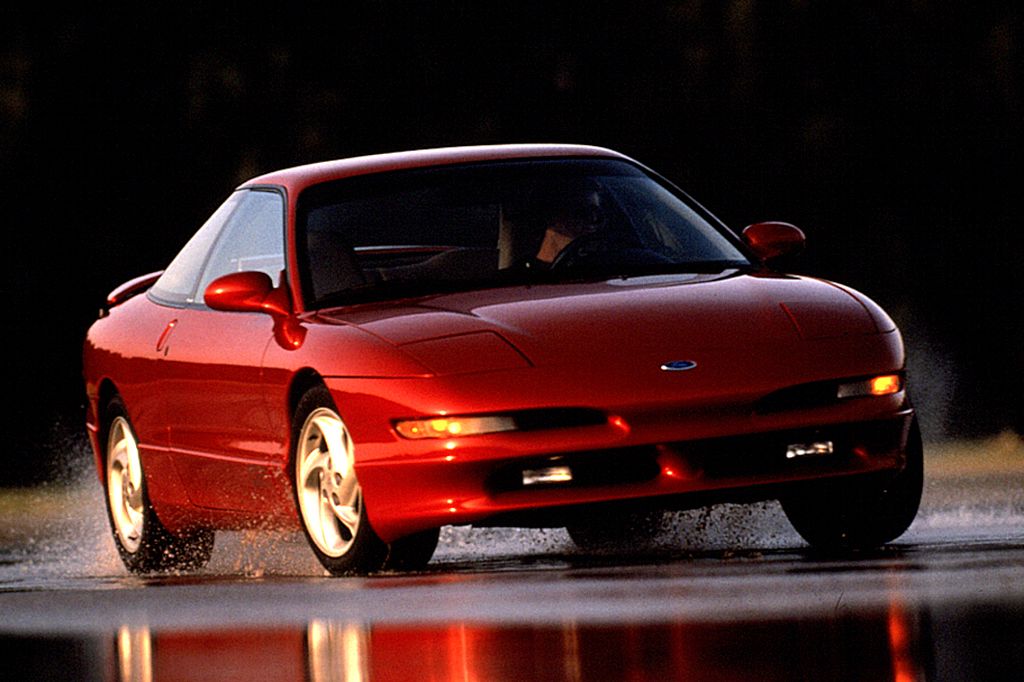The '90s were a weird time for cars, particularly for American ones. The '80s were not a kind decade to the domestic auto industry, as it was then that foreign cars started to make huge gains in the market.
More people began to buy into the idea of a smaller, lighter car with a revving engine, good fuel economy, and crucially, better build quality than American compacts. Domestic manufacturers took notice of this, and so began a decade of some wild badge engineering and grey importing.
One such machine was the Ford Probe GT, a front-wheel-drive sports car built on a Japanese platform with a silly name that was originally meant to replace the Mustang. Thankfully, Ford didn’t push it quite that far – Mustang fans were not exactly thrilled at the idea of their dearly beloved pony car going FWD.
The Ford Probe was based on Mazda’s G Platform, the same architecture that gave us the beautiful MX-6 sports coupe, and it also shared its high-revving KL-series V6 with a couple of Mazda models. Unlike the Mazda, it had pop-up headlights (and a sillier name), but both cars were engineered to perform largely the same.
The Probe is slowly starting to emerge as a cult classic, a darling of Radwood meets and the driveways of 90s fantasists. The Probe was discontinued in 1997, to little fanfare. Read on to find out why Ford pulled the plug on the Probe project only a few years before the turn of the decade.
What’s A Ford Probe?
The quick answer is the Probe is a two-door, four-seat evolution of the personal luxury car. It's sporty, but not a dedicated performance car. It's quick, but not overwhelmingly so, and certainly not enough to get you in serious trouble. It handles well enough, but front-wheel drive and long wheelbases are a combination that doesn't lend itself well to a nimbleness, and the Probe's dynamics tend to lean towards understeer when pushed.
It's a neat-looking car. It's not classically beautiful (its platform-twin, the Mazda MX-6, is far prettier), but it is a product of its time and has some design cues firmly rooted in the '90s, for better or worse. Its pop-up headlights are cool (they're always cool), and the wraparound rear window looks neat, but otherwise it's not a terribly remarkable car.
It wasn't particularly cheap when it was new either, but it was still a value proposition over some European sport-luxury coupes. It retailed for about $15,000 USD, which is about $29,000 USD in today's money. That's what an entry-level Subaru BRZ costs today, to put it in perspective.
But most importantly, the Probe GT was initially an intended replacement for the Mustang, which went over with Mustang enthusiasts about as smoothly as you'd expect it to.
The People Spoke, And Ford Listened
Your eyes don't deceive you. You did just read that Ford thought about making the Mustang a front-wheel-drive car built on a Mazda platform developed in Japan. Sounds crazy, but we do now live in a world where you can buy an electric, four-door, four-wheel-drive CUV called Mustang.
The idea goes back as far as the late-70s when the reality of an oil-starved world had taken its toll on the V8, RWD tradition of American performance cars. The Mustang II was an early attempt to rectify this, but Ford was going to take the idea of an economical Mustang much further than that.
The original concept was called ST-16, built on Mazda's G platform and sharing most of its componentry and drivetrain with the Mazda MX-6 and 626 sedans. in 1987, AutoWeek published a cover story about the Ford Probe concept with the headline: "EXCLUSIVE! The '89 Ford Mustang," Public outcry was immediate.
"AutoWeek readers responded with howls of indignation," writes Don Sherman at Hagerty. "One claimed the idea filled him with rage and disgust. Another urged Mustang fans to share their feelings with Ford commanders and kindly provided the company’s mailing address. Thousands followed that suggestion—to the letter."
The plan was to phase out the Fox Body Mustang, calling it "Mustang Classic" to then make the car that would become the Probe into the next generation 'Stang. Of course, that didn't happen, and Ford instead gave us the frumpy-looking but very much V8-powered and rear-driven SN-95 Mustang. The Probe existed alongside two generations of the pony car and spent its whole life at risk of Vitamin D deficiency from spending so much time in the Mustang's shadow.
It was never a runaway sales success, which no doubt had something to do with the initial poor response to it as a Mustang replacement, and as the 90s wore on the Probe's future was starting to look bleak.
Declining Sales And Hard Times In Japan
In 1993, Ford produced and sold over 100,000 Probes. By 1997, that number had dwindled to less than 20,000, fewer than one fifth, within only five full years of production and sales. This is a sharp drop-off, the likes of which few cars from major manufacturers ever see, but it's a clear indicator that the FWD sport-coupe segment was starting to fade away.
Within Ford's own stables, the Mustang was the obvious choice for performance driving and the Thunderbird was a better personal luxury car. Mazda's MX-6 languished while the rear-driven Miata and RX-7 took off, despite the MX-6 being both more practical than a roadster and its V6 engine more reliable than a rotary unit. Front-drive cars lose much of their dynamic driving ability when the weight goes up and the wheelbase gets longer, and both manufacturers also had stubby, powerful hatchbacks on offer that had much sharper handling than the Probe GT. All it really had going for it were its looks (if they were to your tastes) and its engine.
The other big blow to the Ford Probe was the declining economic situation in Japan in the late 90s. It was a wake-up call moment for many Japanese manufacturers, particularly Mazda, and redundancies in the lineup were no longer favorable if they weren't profitable. As such, the MX-6 was canceled in 1997, which also meant it was curtains for the Probe GT. Though it was manufactured in Michigan, a lot of its parts came from Mazda in Japan, and without that supply, it wouldn't have been possible to make the Probe GT, at least not as it was. It would have needed an extensive redesign on a new platform and, considering its declining popularity in sales, that wouldn't have made much sense financially.
But Ford did make a follow-up to the Probe. It just didn't sell it as a Ford. The Probe's successor was the early-2000s front-drive revival of the Mercury Cougar, which was also not a very successful car.
Ford dropped the Probe mainly because it failed to carve out a place for itself in the market. It was unique, but its Mazda sibling was a better-looking car with a more grown-up name, and people looking for juvenile thrills in a fast Ford rightfully turned their attentions to the Mustang. An economic crisis in Japan didn’t help things either, driving up the cost of a lot of components like the high-revving KL-DE V6, if they were even available at all. Perhaps the Probe’s second life as a cult car will be better than its first.




